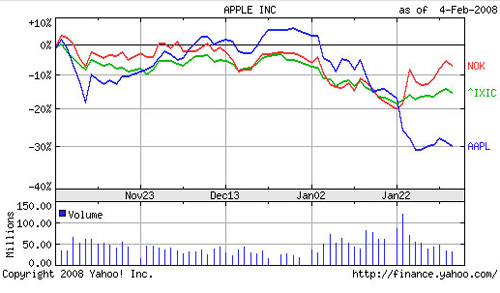|
|
Apple iPhone vs Apple Touch, player wins
I can’t help but love the soap opera called the iPhone – that’s where the true dramaturgy and spirit of the community are. The iPhone’s hype lives on only in the hearts of its devotees, while the manufacturer’s marketing strategy starts going sideways. When I was winding up the previous piece on this handset I was keen to check out AT&T’s data in Q3 and the number of activated iPhones, which was bound to differ from the official statistics tremendously. Whether Apple had a hand in this, or whether they did that on their own, AT&T said nothing on activated phones in the Q3 report, however, early in 2008 they reported on the entire 2007. The numbers over there were, in truth, quite something. Apple claims it sold 3.7 million iPhones as of the end of 2007. However, its senior partner reports 2 million activations.
Adding more fuel to the fire were the European carriers, for whom grabbing hold of the Apple’s product wasn’t easy, (and for some it has become a real pain, like T-Mobile in Germany). Apple pulled out all the stops for its PR machine in Europe, and acted as if they were in the US: when the handset landed in the UK, many blogs, web resources and even newspapers shouted about “people queuing up” to get the precious gadget. On that day I decided to take a walk to Apple’s store on Regent Street and found out that the iPhone was indeed available, but failed to see any sort of queue or battalions of fans dying to get one. The shop assistants told me that the handset enjoyed moderate sales, although they had been instructed that there would be a lot more clients on day one, but as it turned out there was no influx.
Earlier that morning, the shop was surrounded by a “huge” line of fifteen people, each of whom snatched some TV time for himself and gave an interview to journalists. Curiously, there were no other iPhone queues in London. The myth is brilliantly exposed in this report – I strongly recommend that you read it and look through all the photos it offers.

Carriers couldn’t turn a blind eye to this – after all, signing the papers with Jobs they were dreaming of success and thronged stores. In fact, they inflated a tiny wave of PR into an avalanche in the blink of an eye. That is, seeing no crowds at its stores, O2 announced that the iPhone was the hottest device in its portfolio, setting one record after another, although they preferred not to disclose exact numbers. The reason doesn’t take a rocket scientist to figure out – the moment you publish figures you no longer can praise and hype the product, as the big picture reveals itself. One of the major discussions in Q4 2007 was whether O2 would manage to sell 400,000 units in just shy of two months. The Q4 results are now official and widely available – 140,000 activated devices is the number.
T-Mobile in Germany officially claimed that on the day the iPhone went on sale, which was November 9th, they sold 10.000 phones, which is a decent number. But over the next fifty days the sales weren’t as good at only 60.000 units; totaling 70,000 devices in 2007.
The French division of Orange boasted that it was sitting on a gold mine, with 30.000 phones sold over the first 5 days. However, the company’s report on 2007 states that in 2007 only 70,000 iPhones were activated, meaning that sales literally died after the initial boom.
Let’s do some very basic math. Apple officially said it sold 3.7 million phones. Its partners activated 2 million (AT&T), plus 140 thousands for O2, Orange and T-Mobile – 70,000 apiece. This makes the final number – 2.26 million phones. Don’t discount the inventory that is currently on the shelves of stores, and those units that were dispatched by Apple, but are currently in transit (the company considers them “sold” already, although they haven’t made it to consumers’ pockets yet). If we are optimistic, there can’t be more than 350-400 thousands of them.
So, it turns out that a whole million iPhones has been lost by the carriers somewhere along the way, and that’s in spite of the handset being locked; all the hardships with getting it unlocked and the US residents only restriction applied in American stores. By the way, the latter was a sound move to boost the phone’s sales back then – this message got around the Web and forced most profiteers to buy up. However it eventually turned out that it was a complete gaff and the handset was available to everyone, whether you were an American or Russian.
That million of phones that flew away from the carriers aren’t that big of a deal for any manufacturer but Apple. The fact of the matter is that this company gets a share in what subscribers pay – on average, that’s 10 to 20 USD a month. You don’t need to be an expert in crunching numbers to figure out that this million equals at least to 120 million dollars of lost annual profit. Analysts are especially concerned about the iPhone being distributed on unauthorized networks.
Another telling picture is the sales of the LG KU990 in Europe – 550,000 units in five weeks is what an aggressive ad campaign and precise positioning can do, even though the brand doesn’t have the magnitude of Apple. The reason why they won is pretty obvious – the KU990 is a pretty decent product with a clear-cut spec sheet that goes for free on contract. In its turn, Apple can’t put up a similar offering – they can’t just throw this kind of money away, even though they are hurting their sales this way.
At MacWorld that took place in January they reassured everyone that the 10 million units plan for 2008 was still on. However, the collapse of forays into markets outside the US, rapid decline in sales on the home market and the refusal of Chinese carriers to work on Apple’s terms – all this leaves very little to no room for maneuver. This is about the time the Apple Touch should come to mind.
Apple Touch or iPhone’s tender killer
Perhaps the Apple Touch is as much of a solid offering as the iPhone is a meager phone. Basically, it is one of the market’s finest players and is beyond the competition of the day. The intentions behind the fact that they didn’t want to roll it out prior to the iPhone’s debut are very clear, just as the dearth of the Touch they created during the first days of its sales is. They simply couldn’t afford showing a sales curve that trumped the much-hyped Apple iPhone hands down.
Nevertheless, victories in PR are one thing, and what every manufacturer vitally needs are real sales. Interestingly, without much fuss or pushy ad campaign the Apple Touch became a global bestseller, not just an American success. Unlike the iPhone, they were not going to publish details of its sales that would have destroyed them in everyone’s eyes. However they never tired to emphasize that the Touch was a big success, being a device that set a new trend in the industry, and this was all true. The Apple touch is in fact an Internet Tablet type solution (terminals for accessing the Web), that has heavy-duty entertainment features thrown in for good measure. The market hasn’t seen many products of this breed; one of the better examples in this sense is the Nokia N810 that loses to the Touch on several fronts.
Ironically, most regions picked the player instead of Apple’s phone, not just because of the latter’s poor availability, but largely due to it being on the weaker side as a stand-alone solution. While the iPhone was the talk of the town back when it was released, these days it’s not that much of a fancy gadget anymore, as its appeal has eroded over time. Apple is fully aware of this effect, but they can’t release the next version of the handset just yet in view of some technical issues and the necessity to keep the current device afloat. All other manufacturers churn out skin-deep updates to their flagships not because they are so into it, but rather because sales would halt otherwise – people are used to a fast rhythm, and they have absolutely no interest in a six month old phone since they already know every last thing about it. That’s another hint at why the iPhone isn’t a craved offering in Europe – there was no way it could spark a craze over here, as consumers weren’t even thinking of getting a pig in a poke, just like the Americans had done on the handset’s release.
On February 5th, Apple did what everyone had expected it to do – it expanded its portfolio with new editions of both the Touch and iPhone, sporting beefed up memory capacities. This leads us to the following:
| |
Touch |
iPhone |
| 8 Gb |
299 USD |
399 USD |
| 16 Gb |
399 USD |
499 USD |
| 32 Gb |
499 USD |
Âîçìîæíî, ñåíòÿáðü 2008 ãîäà |
Undoubtedly, the Apple Touch gains a whole lot with this expansion, for it will boost its sales, enticing those who couldn’t make up their minds in view of the players’ tiny storage space towards getting the Touch. On top of that, Apple’s latest high-definition video initiate makes it all the more appealing. And while the Touch won’t have star-high sales, it will still enjoy some great numbers. The player’s versions with less storage are leaving the shelves very well too, although the demand has been dropping compared to the pre New Year level.
Now let’s think of how it is going to turn out for the Apple iPhone. The move is aimed primarily at the previously uncovered audience, as those 100 USD they have taken off the price tag don't seem to be much of a difference. Back when there were only 4 Gb and 8 Gb versions available, the choice was pretty much clear-cut – the senior offering looked like the winner, although it retailed for 599 USD right after its launch. A two-year contract with an exclusive carrier is, in effect, a perfect way to prevent those who have already bought the iPhone from grabbing a new, more capable unit. But I also have to note that there will be very few people with 16 Gb Touch players willing to get a 32 Gb model instead.
Price-wise, the iPhone ends up way behind the Touch largely due to the two-year contact going with it. Plus, given how little of a phone it is, Apple’s handset doesn’t seem capable of much when compared with other offerings in the market, meaning that their portfolio is obviously more weighted towards its Touch end.
Apple’s propaganda can’t turn back halfway, that’s why the Apple iPhone, no matter how weak a product it is, remains its focus. Basically, it needs all the help it can get since its sales are dropping every day, and now that the MWC is over, the iPhone will have to step into the shadow of solutions delivered by other vendors. What moves are left in Apple’s arsenal that could rocket the iPhone back to the top?
Not many, that’s for sure. The most effective scenario would be to generate sales in the US that would supply the iPhone to regions where this handset is not official yet and won’t be available in 2008. This seems possible if two conditions are met. First, consumers should be aware that the process of unlocking the handset is easy and very straightforward, second – they should charge less for the iPhone.
Well, the former is not really an issue – the story of wonderkids cracking iPhone firmware versions like peanuts can make one laugh. My favorite part was when, after some strong arguments within one of these groups, its member released the encryption key for all current firmware versions. I’m curious why nobody wondered how a kid could get this precious key? With no supercomputers at his disposal or 5 years of non-stop deciphering, there is only one way how it could make it into his hands – the key was tossed by someone who had created it. That’s not the only strange thing about how they cracked the iPhone, as these “hackers” can’t master the phone’s firmware on their own, and what is more, never could. Apple is being pressured by carriers, AT&T in particular, which couldn't hate the thought of letting phones slip out of their networks more. So Apple is between two fires, as they are ought to make it look like they are doing everything possible to deal with “hackers”. This way, after a continuous struggle they will find a way into the new firmware, while Apple will lift its hands in dismay and ensure everyone interested that they will do better with the next version.

The thing is, they need to roll out methods to crack the iPhone’s firmware only along with price cuts, so as to allow for the flow of phones outside of the US. Why wouldn’t they drop the price already today? It is highly unadvisable, as they would need to alter the Apple Touch’s price too, which is generating great sales as it is, meaning that it still has some unused potential. Only after Apple has squeezed the last dollar out of it, will they withdraw the junior version from the market and then cut the prices by 100 USD. So the main question is when it is going to happen. As I see it, the best time to do that will come along in two-three months’ time.
Apple’s investors are perfectly aware of what’s going on, so after MacWorld, against the backdrop of the downswing IT companies are currently on, Apple’s shares also dropped. The updates to the Touch and iPhone got a cold welcome accompanied by 1.85 dip in the share price.

Another possible scenario is the launch of the phone in different regions whilst getting it locked, not to particular carriers, but the region’s cellular networks. In fact, that’s the way Orange’s officially unlocked phones run in France. This won’t allow Apple to capitalize on subscribers and will provoke heavy criticism from the four carries with exclusive distribution rights, but that’s how they can reach the 10 million units mark. On the other hand, it won’t be a big deal for Apple’s PR team to announce tomorrow that they are on the 10 millionth iPhone, and the fact that carriers’ data won’t indicate the same thing… well, that will be their own headache, that won’t concern Apple. What Apple is really concerned about is the second-generation iPhone that is very unlikely to debut sooner than second half of 2008, since they have run into some serious technical issues.
P.S. In 2007 around 200.000 Apple iPhones were imported and sold in Russia, making this market the second largest worldwide after the US. However, our market is experiencing a dramatic decline in demand for the iPhone as well, with some delays though, all thanks to the Apple Touch.
Related links:
Eldar Murtazin (eldar@mobile-review.com)
Translated by Oleg Kononosov (oleg.kononosov@mobile-review.com)
Published — 25 February 2008
Have something to add?! Write us... eldar@mobile-review.com
|
News:
[ 31-07 16:21 ]Sir Jony Ive: Apple Isn't In It For The Money
[ 31-07 13:34 ]Video: Nokia Designer Interviews
[ 31-07 13:10 ]RIM To Layoff 3,000 More Employees
[ 30-07 20:59 ]Video: iPhone 5 Housing Shown Off
[ 30-07 19:12 ]Android Fortunes Decline In U.S.
[ 25-07 16:18 ]Why Apple Is Suing Samsung?
[ 25-07 15:53 ]A Few Choice Quotes About Apple ... By Samsung
[ 23-07 20:25 ]Russian iOS Hacker Calls It A Day
[ 23-07 17:40 ]Video: It's Still Not Out, But Galaxy Note 10.1 Gets An Ad
[ 19-07 19:10 ]Another Loss For Nokia: $1 Billion Down In Q2
[ 19-07 17:22 ]British Judge Orders Apple To Run Ads Saying Samsung Did Not Copy Them
[ 19-07 16:57 ]iPhone 5 To Feature Nano-SIM Cards
[ 18-07 14:20 ]What The iPad Could Have Looked Like ...
[ 18-07 13:25 ]App Store Hack Is Still Going Strong Despite Apple's Best Efforts
[ 13-07 12:34 ]Infographic: The (Hypothetical) Sale Of RIM
[ 13-07 11:10 ]Video: iPhone Hacker Makes In-App Purchases Free
[ 12-07 19:50 ]iPhone 5 Images Leak Again
[ 12-07 17:51 ]Android Takes 50%+ Of U.S. And Europe
[ 11-07 16:02 ]Apple Involved In 60% Of Patent Suits
[ 11-07 13:14 ]Video: Kindle Fire Gets A Jelly Bean
Subscribe
|



